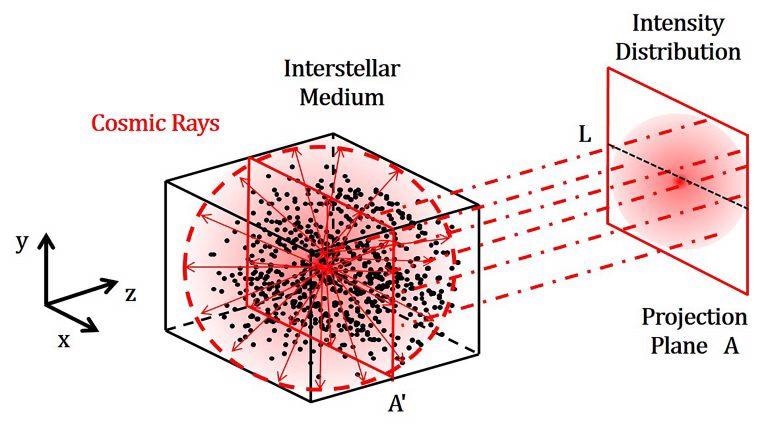May 26 2021
Cosmic rays are essentially high-energy atomic particles that constantly bombard the surface of the Earth at virtually the speed of light.
 Schematic representation of cosmic rays propagating through magnetic clouds. Image Credit: Salvatore Buonocore.
Schematic representation of cosmic rays propagating through magnetic clouds. Image Credit: Salvatore Buonocore.
The Earth has a magnetic field that protects its surface from most of the radiation produced by these particles. But despite this fact, cosmic rays can still cause electronic failures and are a major concern in preparing for space missions.
Scientists already know that cosmic rays emerge from an unlimited number of stars in the Milky Way galaxy, including the Sun and other types of galaxies. But it is hard to trace the particles to particular sources because the turbulence of dust, plasma and interstellar gas makes these particles scatter and rescatter in various directions.
Researchers from the University of Notre Dame have now designed a simulation model to better interpret these phenomena and other characteristics of cosmic ray transport. The researchers’ goal is to design algorithms that improve the present detection methods. The study has been published in AIP Publishing’s AIP Advances journal.
Brownian motion theory is usually applied to analyze the trajectories of cosmic rays. Similar to the arbitrary movement of pollen particles in a pond, collisions that occur between cosmic rays inside the varying magnetic fields make the particles push in various directions.
However, this traditional diffusion strategy does not sufficiently deal with the varied propagation rates influenced by extended spells of cosmic voids and different interstellar environments. Particles can get trapped for a period in magnetic fields, which tend to slow them down, whereas others are propelled into greater speeds through the explosion of stars.
To tackle the intricate nature of cosmic ray trajectory, the investigators used a stochastic scattering model—a collection of arbitrary variables that evolve in due course. This stochastic scattering model is based on geometric Brownian motion, which is a traditional diffusion concept integrated with a slight trajectory drift in a single direction.
During their initial experiment, the researchers replicated cosmic rays that travel via interstellar space and interact with localized magnetized clouds, denoted as tubes. The cosmic rays then travel uninterrupted across a long duration of time.
But these rays are disturbed when they interact randomly with the localized magnetized clouds, and this causes some of the rays to reemit in arbitrary directions, while others remain trapped.
Monte Carlo numerical analysis, which is built on repeated arbitrary sampling, demonstrated reemission strengths and density ranges of the interstellar magnetic clouds, resulting in heavy-tailed, or skewed, distributions of the propagating cosmic rays.
The study indicates marked superdiffusive behavior. The predictions made by the model correspond well with the familiar transport characteristics in complex interstellar media.
Our model provides valuable insights on the nature of complex environments crossed by cosmic rays and could help advance current detection techniques.
Salvatore Buonocore, Study Author, University of Notre Dam
Journal Reference:
Buonocore, S & Sen, M (2021) Anomalous diffusion of cosmic rays: A geometric approach. AIP Advances. doi.org/10.1063/5.0049401.